Piston Groove Machining Tool
Naschberger; Manuel ; et al.
U.S. patent application number 16/312313 was filed with the patent office on 2019-08-01 for piston groove machining tool. The applicant listed for this patent is GE Jenbacher GmbH & Co. OG. Invention is credited to Patrick Hotter, Manuel Naschberger.
| Application Number | 20190232376 16/312313 |
| Document ID | / |
| Family ID | 59298457 |
| Filed Date | 2019-08-01 |
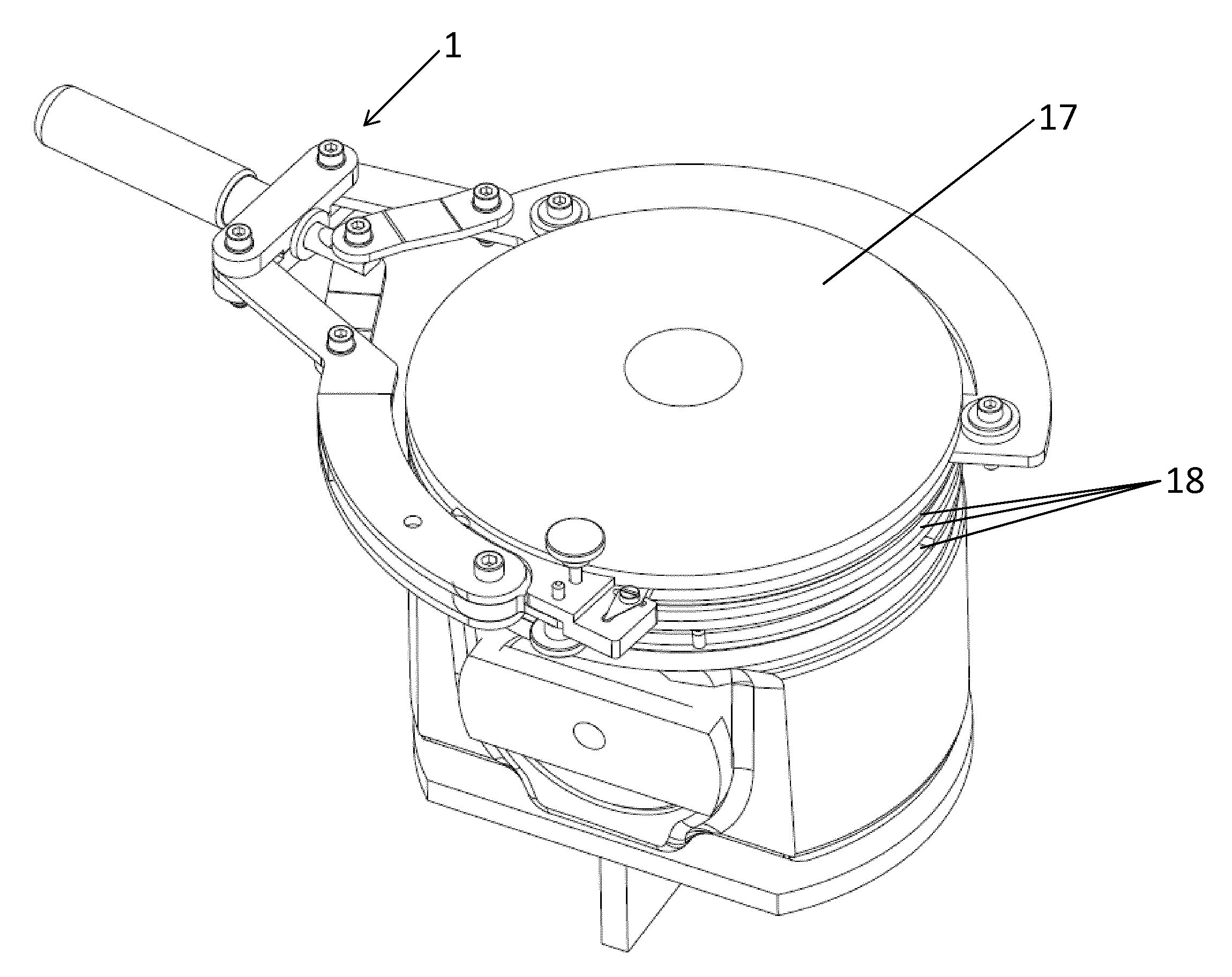
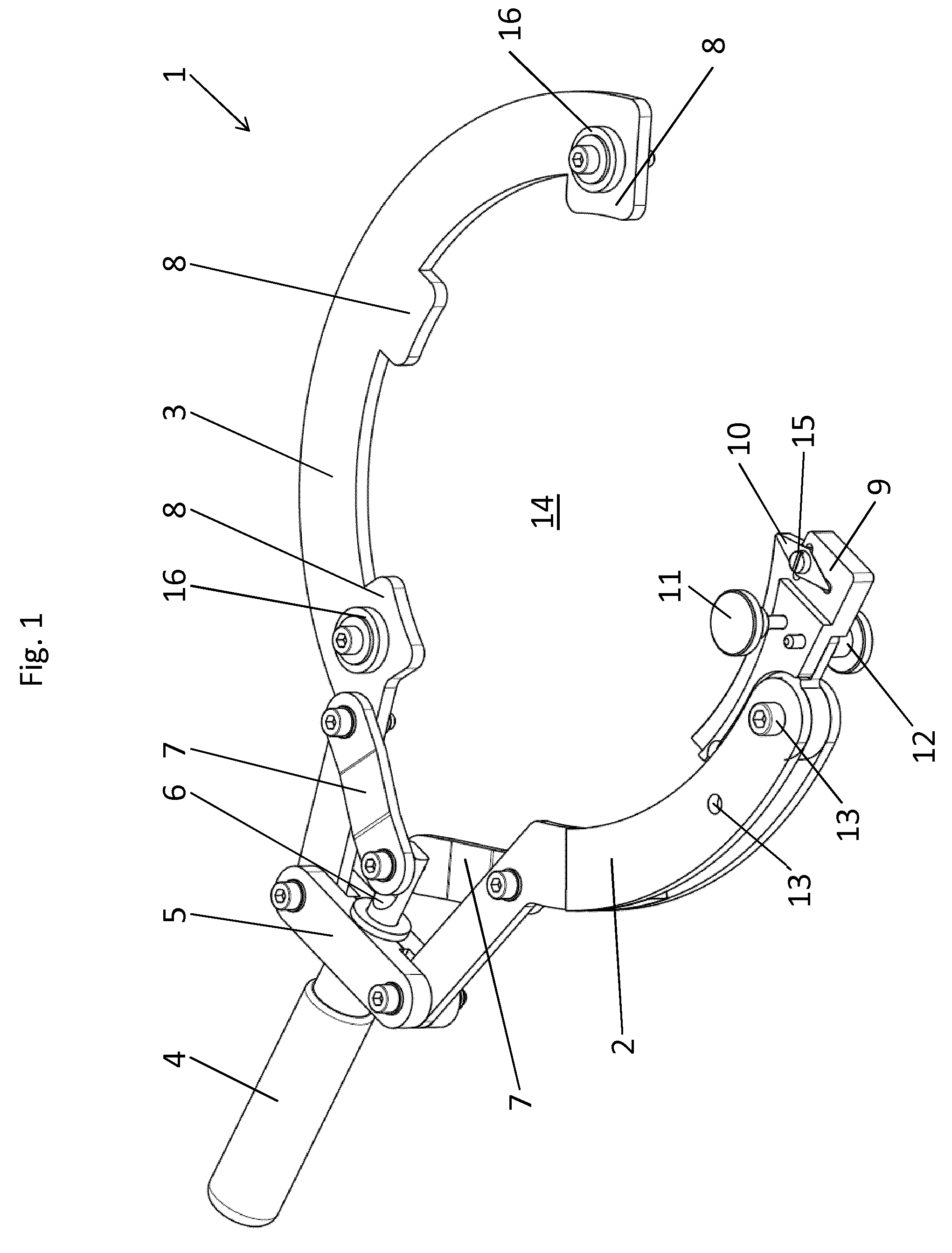
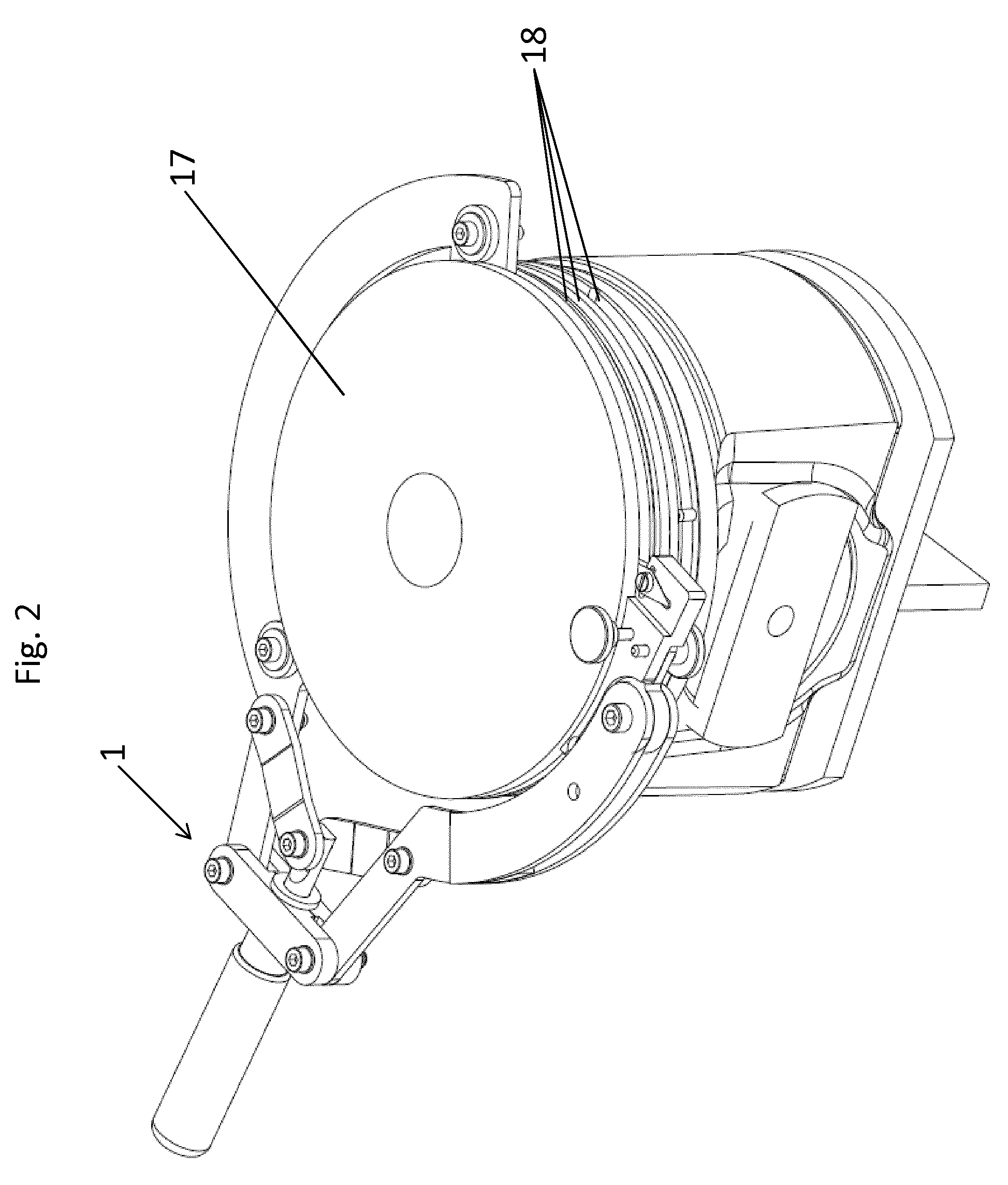
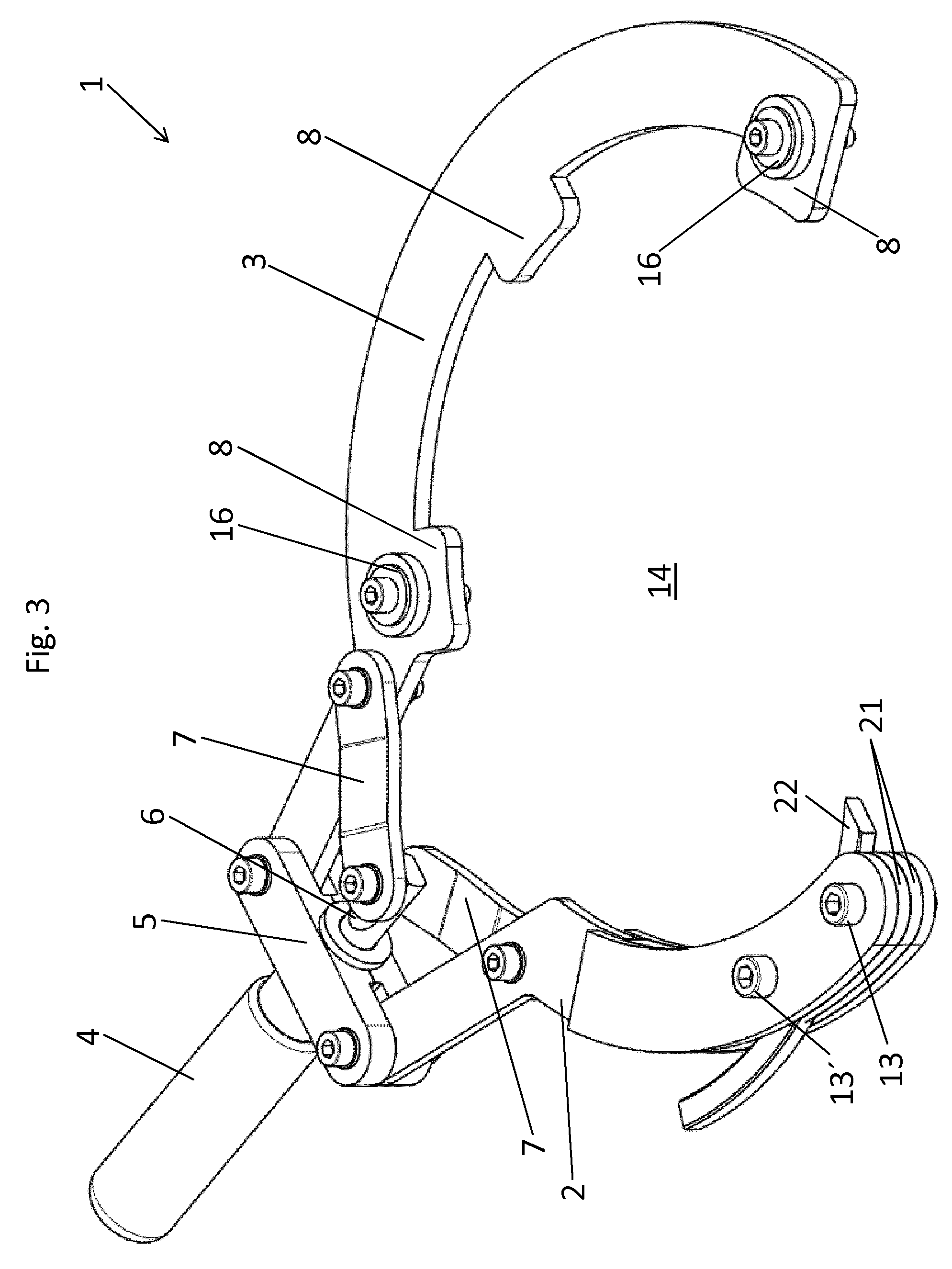
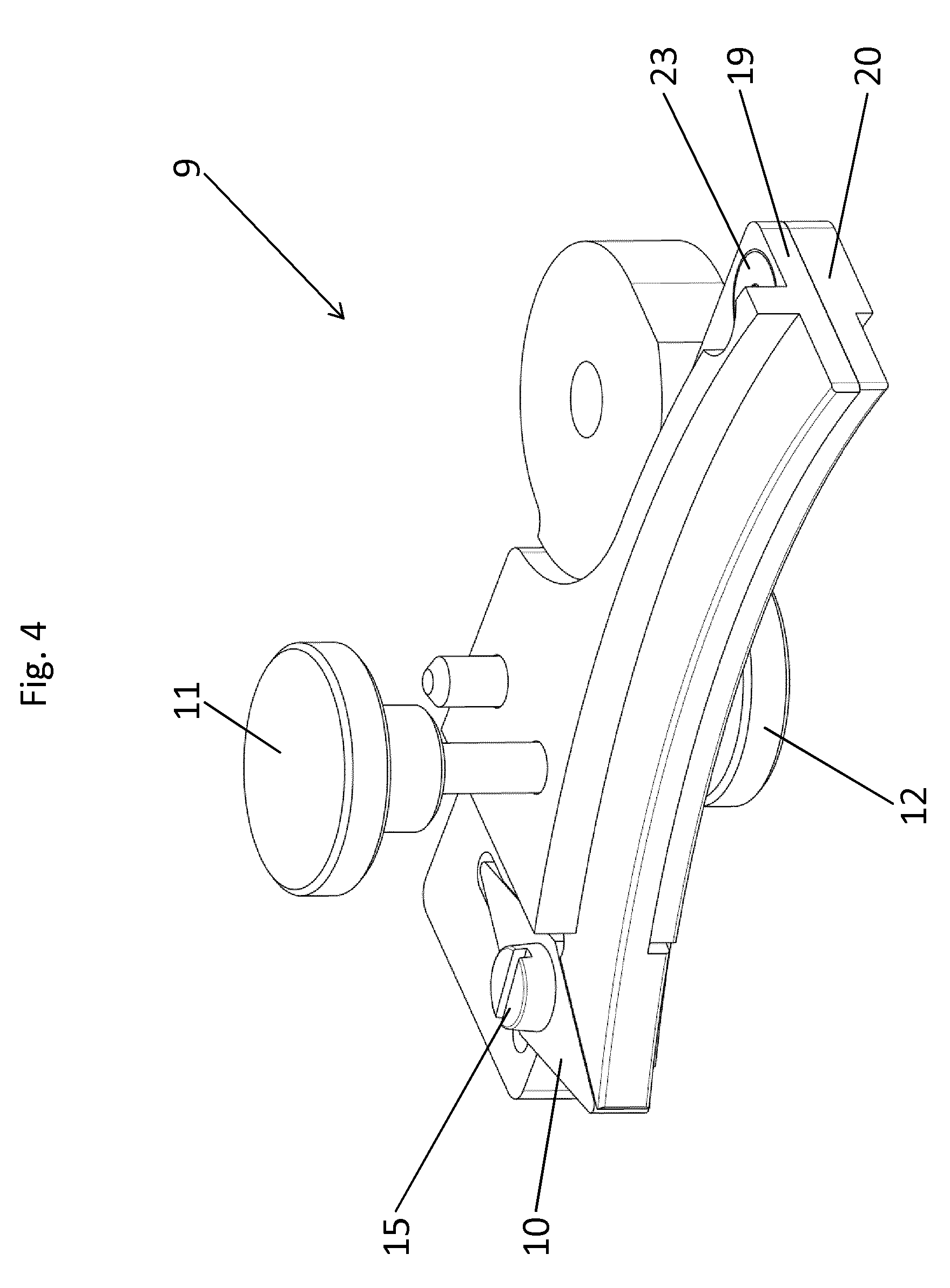
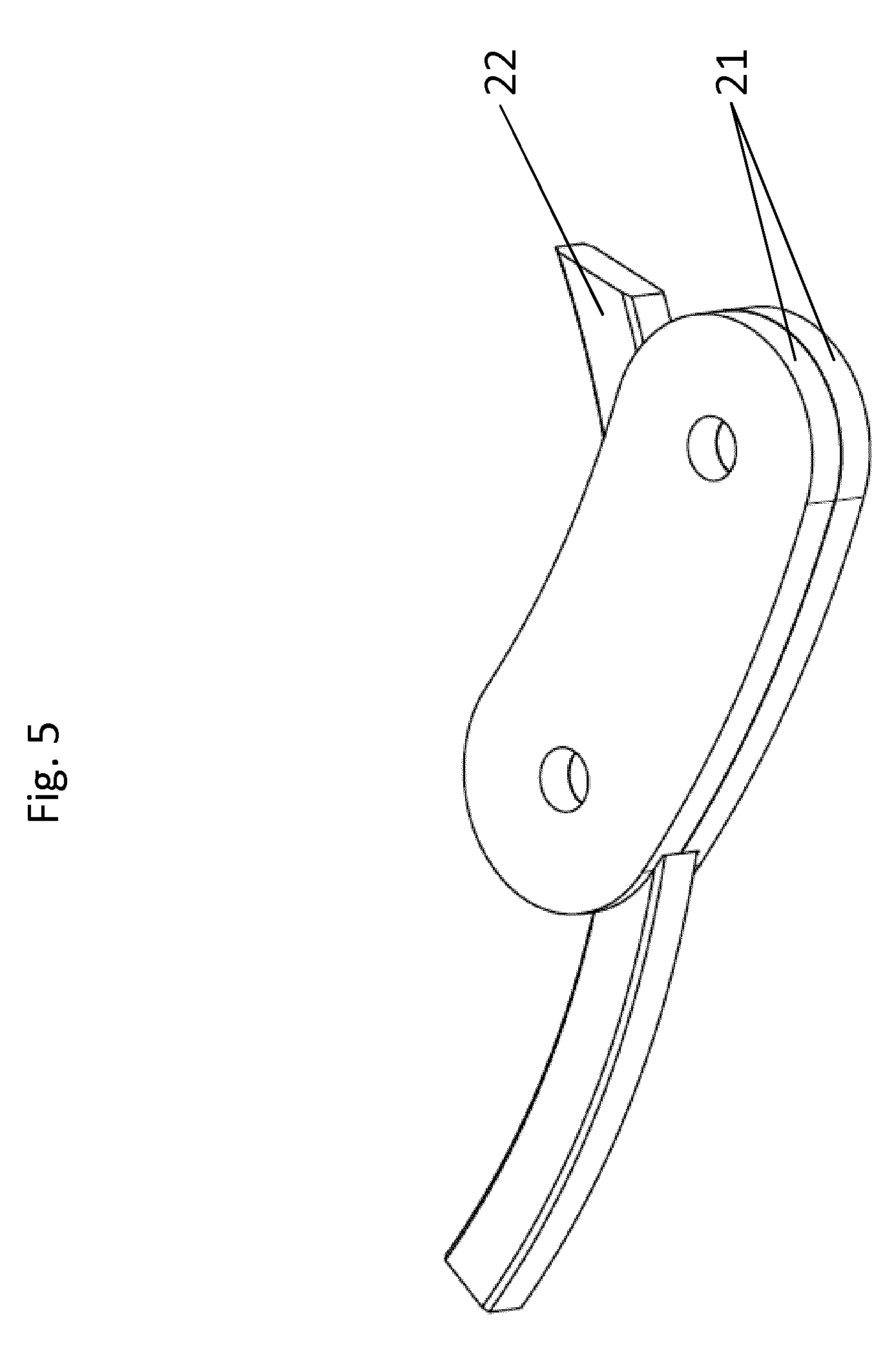
| United States Patent Application | 20190232376 |
| Kind Code | A1 |
| Naschberger; Manuel ; et al. | August 1, 2019 |
PISTON GROOVE MACHINING TOOL
Abstract
A tool for machining a groove of a rotation-symmetric component, preferably a piston of an internal combustion engine, is provided. The machining is carried out by a rotation of the tool around an axis of symmetry of the rotation-symmetric component to be machined. The tool includes at least one arm disposed in such a way that a circumference of the rotation-symmetric component can at least be partially enclosed. Also, a machining device for machining of the groove is provided on the at least one arm. At least one adjusting device is provided. With the help of the at least one adjusting device, a contact force on the rotation-symmetric component of the at least one machining device can be selected. Further, the tool includes an adjusting device with which the tool can be adapted to different diameters of a rotation-symmetric component.
| Inventors: | Naschberger; Manuel; (Jenbach, Tyrol, AT) ; Hotter; Patrick; (Jenbach, Tyrol, AT) | ||||||||||
| Applicant: |
|
||||||||||
|---|---|---|---|---|---|---|---|---|---|---|---|
| Family ID: | 59298457 | ||||||||||
| Appl. No.: | 16/312313 | ||||||||||
| Filed: | July 7, 2017 | ||||||||||
| PCT Filed: | July 7, 2017 | ||||||||||
| PCT NO: | PCT/EP2017/067084 | ||||||||||
| 371 Date: | December 21, 2018 |
| Current U.S. Class: | 1/1 |
| Current CPC Class: | B23B 3/24 20130101; B23D 79/04 20130101; B23B 5/00 20130101 |
| International Class: | B23B 3/24 20060101 B23B003/24; B23D 79/04 20060101 B23D079/04 |
Foreign Application Data
| Date | Code | Application Number |
|---|---|---|
| Jul 7, 2016 | AT | 50605/2016 |
Claims
1. A tool for machining a groove of a rotation-symmetric component, preferably a piston of an internal combustion engine, wherein the machining is carried out by a rotation of the tool around an axis of symmetry of the rotation-symmetric component to be machined, the tool comprising: at least one arm disposed such that a circumference of the rotation-symmetric component can at least be partially enclosed; a machining device for machining of the groove arranged on the at least one arm; at least one adjusting device operable for selecting a contact force on the rotation-symmetric component of the at least one machining device; and an adjusting device for adapting the tool to different diameters of a rotation-symmetric component, wherein the adjusting device comprises a first and a second half shell, whose distance to one another can be adjusted by a first control element and locked by a second control element.
2. The tool according to claim 1, further comprising at least one machining device is designed as a cutting tool.
3. The tool according to claim 2, wherin a width of the at least one machining device is modifiable in a direction perpendicular to the extent of the at least one arm and parallel to a diameter of the at least one arm.
4. The tool according to claim 2, wherein the at least one machining device is attached interchangeably.
5. The tool according to claim 1, wherein the at least one machining device is designed as an abrasive element.
6. The tool according to claim 5, wherein a width of the at least one machining device is modifiable in a direction perpendicular to the extent of the at least one arm and parallel to a diameter of the at least one arm.
7. The tool according to claim 5, wherein the at least one machining device is attached interchangeably.
8. The tool according to claim 1, wherein the at least one machining device is disposed such that a groove base of the groove can be machined.
9. The tool according to claim 1, wherein the at least one machining device is disposed such that at least a groove flank of the groove can be machined.
10. The tool according to claim 1, wherein the first and the second control element comprise an offset relative to each other, so that the at least one machining device is capable of specifically being tilted to a sloping position.
11. The tool according to claim 1, wherein a guiding device for guiding the tool on the groove is provided on the at least one arm.
12. The tool according to claim 1, wherein guiding elements of a guiding device are designed to allow a rotation of the tool around the rotation-symmetric component to be machined, but ensure a particular position in an axial direction.
13. The tool according to claim 12, wherein guiding device is disposed interchangeably.
14. The tool according to claim 1, wherein a first arm and a second arm are provided.
15. The tool according to claim 14, wherein the at least one machining device is provided on the first arm and a guiding device for guiding the tool is provided on the second arm.
Description
TECHNOLOGY FIELD
[0001] The disclosure relates to a tool for machining a groove of a rotation-symmetric component with the characteristics of the preamble of claim 1.
BACKGROUND OF THE DISCLOSURE
[0002] A tool for machining a groove of a rotation-symmetric component is sometimes an essential aid in maintenance work of an internal combustion engine. The emphasis here is on easy handling and high quality of machining.
[0003] An exemplary tool is disclosed in U.S. Pat. No. 3,188,670. Here, a pincer-like tool, which comprises two arms, is placed over a piston to be machined and is placed in its groove with a machining element. A machining element for cleaning the groove is disposed on one arm, and a guiding device on the other arm for securing the position during the machining. The contact force of the machining element on the piston is thereby achieved in an undefined manner by a manual pressing together of the arms to one another.
[0004] The drawback of tools for machining a groove of a piston known from the prior art is that such a class-specific tool provides only very little variability in relation to the diameter of a rotation-symmetric component. Furthermore, a defined setting of the contact force/machining force is not possible, since it is usually applied by manual pressing.
SUMMARY OF THE DISCLOSURE
[0005] Task of the disclosure is to provide a class-specific tool to ensure an enhanced ability for machining a groove of a rotation-symmetric component.
[0006] This task is solved with a tool having the characteristics of claim 1. The embodiments of the disclosure are defined in the dependent claims.
[0007] It ensures a constant and precisely defined contact force across the entire area to be machined, which results in a high quality of the work result. Because a tool according to the disclosure can be adapted to different diameters by means of an adjusting device, there is no longer a need to resort to a plurality of tools to be able to machine different components (in relation to their diameter).
[0008] It can be provided that at least one machining device is designed as a cutting tool. A cutting tool is mostly used in this context to clean or rework a groove of a rotation-symmetric component. Especially in maintenance work of pistons, which already had exposure to the operating conditions, this is often required, to eliminate impurities (such as soot) or slight damage to the edges of the groove.
[0009] It can be provided that a width of the at least one cutting tool is modifiable in a direction perpendicular to the extent of the at least one arm and parallel to a diameter of the at least one arm. Such a variability with respect to the width of a groove to be machined creates on the one hand the opportunity to carry out the machining in several steps in case of heavy dirt or damage, thereby approaching the final dimensions step by step, and on the other hand a degree of flexibility for machining different components with different widths is attained.
[0010] It can be provided that the at least one cutting tool is attached interchangeably. With the help of such an arrangement it is ensured that the cutting tool can be replaced quickly and easily, if due to wear or damage on the cutting tool the desired quality of the machining can no longer be achieved.
[0011] It is provided that the at least one machining device is designed as an abrasive element. High accuracies and surface qualities can be achieved by machining a groove with an abrasive element. Such machining can be done, for example, after machining with a cutting tool.
[0012] It can be provided that a width of the at least one abrasive element is modifiable in a direction perpendicular to the extent of the at least one arm and parallel to a diameter of the at least one arm.
[0013] It can be provided that the at least one abrasive element is disposed interchangeably.
[0014] It is provided that the at least one machining device is disposed in such a way that a groove base of a groove is machinable.
[0015] It can be provided that the at least one machining device is disposed in such a way that the at least one groove flank of a groove is machinable.
[0016] It can be provided that the at least one machining device is capable of specifically being tilted to a sloping position. Such tilting of the machining device to a sloping position ensures a machinability of slopped grooves (grooves which have an angular position or an angular position of the groove flanks).
[0017] It can be provided that a guiding device to guide the tool on the groove is provided on at least one arm.
[0018] It is provided that guiding elements of the guiding device are designed to allow a rotation of the tool around the rotation-symmetric component to be machined, but ensure a particular position in axial direction.
[0019] It can be provided that the guiding device is disposed interchangeably.
[0020] It can be provided that the guiding device is modifiable in its width.
[0021] A first arm and a second arm are provided.
[0022] It can be provided that on the first arm the at least one machining device is provided and that on the second arm the guiding device for the guiding of the tool is provided.
BRIEF DESCRIPTION OFTHE DRAWINGS
[0023] Exemplary embodiments of the disclosure are discussed with reference to the Figures. The drawings in detail:
[0024] FIG. 1 shows a tool according to the disclosure in perspective view;
[0025] FIG. 2 shows the tool of FIG. 1 in a position that is applied to a piston;
[0026] FIG. 3 shows the tool of FIG. 1;
[0027] FIGS. 4a, b show the holder together with the cutting blade for the groove flanks in isolation; and
[0028] FIG. 5 shows the holder together with the cutting blade for the groove base in isolation.
DETAILED DESCRIPTION
[0029] In the figures shown, the rotation-symmetric component to be machined is designed in an exemplary manner as piston 17 with at least one piston groove 18 to be cleaned.
[0030] FIG. 1 shows a perspective view of an exemplary embodiment of a tool 1 with a first arm 2 and a second arm 3 and a handle 4 according to the disclosure. For the machining of a piston groove 18 of a piston 17 (see FIG. 2) the tool 1 is manually guided by means of the handle 4 once or several times around the piston 17.
[0031] On the first arm 2 (in the area of the free end of the first arm 2), a holder 9 is detachably mounted by the fastening element 13, which in the state shown carries a cutting tool 10 (hereinafter referred to as "cutting blade") for the machining of the groove flanks of a selected piston groove 18 of a piston 17.
[0032] A guiding device is disposed on the second arm 2, which is here designed in the form of three guiding elements 8 distributed over the length of the second arm 2 and two guide rollers 16 disposed at the ends of the second arm 2.
[0033] Between the first arm 2 and the second arm 3 is a gap 14 designed for positioning of the rotation-symmetric component to be machined (here a piston 17--see FIG. 2). An adjusting device is provided for adaption of tool 1 to different diameters of the rotation-symmetric component, which in the shown exemplary embodiment can change the swivel position of the first arm 2 and of the second arm 3 relative to each other. A knee lever with two lever arms 7 is provided for this purpose, where each lever arm 7 is connected at one end with one arm 2, 3 of the tool 1 and is connected on the other end (knee) to a spindle 6. A linear movement of the spindle 6 in the shown exemplary embodiment can occur via the rotatable disposed handle 4 on the bearing 5. If the spindle 6 moves further out of the bearing 5, this increases the diameter of the gap 14 for positioning of the rotation-symmetric component to be machined. If the spindle 6 moves further into the bearing 5, this decreases the diameter of the gap 14 for positioning of the rotation-symmetric component to be machined.
[0034] The holder 9 in FIG. 1, which is detachably mounted by the fastening element 13 on the first arm 2 (which can be swiveled around an axis formed by the fastening element 13), comprises an adjusting device by means of which the contact force of the cutting blade 10 for the machining of the groove flanks, with which it is pressed against the groove flanks of the piston grooves 18, can be selected. The adjusting device consists of a first and a second half shell 19, 20 of the holder 9 for the cutting blade 10 for the machining of the groove flanks (see also FIG. 4), whose distance to one another can be adjusted by a first control element 11 and locked by a second control element 12. The adjustment is carried out so as to achieve a larger contact force, the distance between the first and second half shell 19, 20 is increased. To achieve a smaller contact force, the distance between the first and second half shell 19, 20 is decreased.
[0035] To change the cutting blade 10 for the machining of the groove flanks (which is designed here as a rotating cutting blade), the fixing element 15, designed here as a screw, is loosened and the cutting blade 10 for the machining of the groove flanks is removed and, as appropriate, re-inserted in turned position. Of course, an exchange of the cutting blade 10 for the machining of the groove flanks can also be done. A removal of the holder 9 from the first arm 2 is not required.
[0036] The guide rollers 16 of the guiding device disposed on the second arm 3 facilitate guiding the tool 1 around the piston and limit the insertion depth of the guide elements 8 into the piston groove 18.
[0037] FIG. 3 shows the tool 1 shown in FIG. 1, wherein the holder 9 for the cutting blade 10 together with the cutting blade 10 for the machining of the groove flanks has been removed and wherein a cutting blade 22 for machining a groove base of the piston groove 18 was mounted instead. It is detachably fixed between two clamping jaws 21. The contact force, with which the cutting blade 22 is pressed against the groove base for machining a groove base, can be adjusted via the handle 4. A higher contact force results when the first and second arms 2, 3 are moved towards one another. A lower contact pressure results when the first and second arms 2, 3 are moved away from one another.
[0038] FIG. 4 shows the holder 9 for the cutting blade 10 for the groove flanks together with the cutting blade 10 in isolation. It is clearly visible that (as already described for FIG. 1) the adjusting device consists of a first and a second half shell 19, 20, which are connected to each other by a fixing element 23. For the machining of the groove flanks, the distance between the half shells 19, 20 relative to one another can be adjusted by the first control element 11 and locked by the second control element 12. In order to detachably dispose the cutting blade 10 on the first half shell 19, in this exemplary embodiment the fixing element 15 for the cutting blade 10 is designed as a screw. It should be noted that the first control element 11 of the adjusting device for the contact force and the second control element 12 for the locking comprise an offset relative to one another (see FIG. 4b). Due to this geometrical situation, it is possible to adjust an angular position of the half shells 19, 20 relative to each other. This makes it possible to machine groove flanks that are disposed at a slopped angle.
[0039] FIG. 5 shows the holder of the cutting blade 22 for the groove base together with the cutting blade 22 in isolation. Here, it is clearly visible how the cutting blade 22 for machining of the groove base is fastened by the clamping between the clamping jaws 21.
[0040] It is also possible, in the case of a tool 1 according to the disclosure, to develop further holders for holding other machining tools. Here, reference is made, by way of example, to a holder for an abrasive element for fine machining.
* * * * *
D00000

D00001

D00002

D00003

D00004

D00005

XML
uspto.report is an independent third-party trademark research tool that is not affiliated, endorsed, or sponsored by the United States Patent and Trademark Office (USPTO) or any other governmental organization. The information provided by uspto.report is based on publicly available data at the time of writing and is intended for informational purposes only.
While we strive to provide accurate and up-to-date information, we do not guarantee the accuracy, completeness, reliability, or suitability of the information displayed on this site. The use of this site is at your own risk. Any reliance you place on such information is therefore strictly at your own risk.
All official trademark data, including owner information, should be verified by visiting the official USPTO website at www.uspto.gov. This site is not intended to replace professional legal advice and should not be used as a substitute for consulting with a legal professional who is knowledgeable about trademark law.